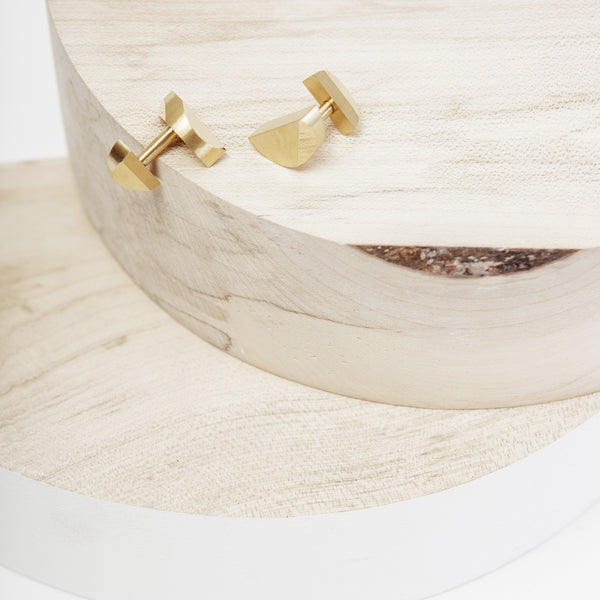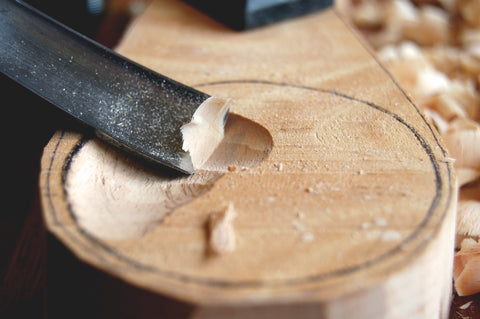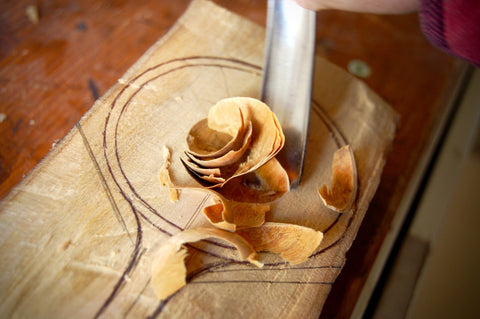Stories

A Range of Cufflinks
Posted by Clare Grennan in: contemporary jewellery, cufflinks, geometric jewellery, handmade

Our very own jewellery line Names Dublin was launched last Autumn. Even after months of brainstorming and experimenting in the studio, we could not have predicted how popular it would prove to be. Over the months leading up to Christmas, we noticed how much our male customers seemed to really love the jewellery, the appeal being the bold geometric shapes, the matte and polished surfaces, the satisfying weight of the brass.
The idea of producing a range of cufflinks seemed like a natural progression for Names, and so in January we began prototyping. What has always bothered myself and Laura about cufflinks are the backs, how flimsy they tend to be, an afterthought to the design of the front. Our focus was to produce each cufflink as one complete shape, giving equal importance to the front and back, ensuring both complimented each other perfectly. Constructed in three parts, each cufflink has been formed by cold connection, as in there was no soldering involved. By using this process, the end result is much cleaner and a strong geometric design is achieved.
The overall process, from initial drawings to finished pieces has been a challenge, but we are really pleased with the end result. The four designs in the range are named after our fathers and grandfathers, John, George, Martin and Mick. Each set of cufflinks is available in either rose or yellow 18carat gold plated brass and packaged in our custom made jewellery boxes.

Helen Faulkner - Process & Planters
Posted by Anna Crudge in: Áras, Down Arts Centre, handmade, Helen Faulkner
We have been fans of Helen Faulkner's work for some time now, the contrast between the dark terracotta clay and the creamy coloured glazes she uses is very appealing. We were delighted when she agreed to create a range of plant pots for Áras, our new collection of home wares. We interrupted the production of our new plant pots with a few questions about what inspires her work and how it is made.

How did you first get into working with clay?
I was introduced to clay during a foundation art course but the first time I got to trying throwing on the potters wheel was a couple of years later on my Contemporary Craft Degree in England and from then on it was all I wanted to do.
What inspires the shapes and colours of your pieces?
My inspiration comes from how the pots are going to be used. I love cooking and eating! So my tableware range is all about food, a smooth curve on the base of a mug that rests comfortably in the hand or thinking about what colours the food will look great on, such as a leafy green salad in a bright blue bowl.
You have designed a collection of plant pots for us, what was the most challenging aspect of the project? what was the most enjoyable?
Making a final decision on decoration was hard, throughout the design process I go through so many ideas that it can be hard to settle on just one. I really enjoyed going through the design ideas sent sent through by yourselves, trying to pull out the most important aspects of the design to you and bringing them together with my style and ideas, it's a challenge I enjoy!

What sort of plants do you envisage people putting in the pots? Did you have something specific in mind when designing/prototyping?
With the tall pot I can imagine spider plants, the stripy leaves that droop down would be a great contrast against the rich red clay. I can imagine mini cactus in the shallow pot but something a bit more useful would be an aloe vera plant. A row of tall plant pots would also look great in the kitchen with herbs in them, again I just can't help but bring it back to food!
Are you currently working on any other new/exciting projects?
I'm working towards a group exhibition that's happening in Down Arts Centre where I have my studio, it's part of August Craft Month in Northern Ireland that is a month long collection of events celebrating crafts, lots of workshops and talks happening too.
What is the greatest and worst part of being self employed?
The best part of being self employed, aside from making pots every week, is the control over my working life and deciding what is important for me. The hardest part of being self employed is nearly the same thing, having to control every aspect is a massive juggling act and sometimes I mess it up but it's all learning so I just start again the next day!
Finally, what do you most like to do on your days off? Do you give yourself days off?
I spend my spare time cooking, I love spending time in the kitchen although I usually end up with a lot of dishes to do because I like to use all the pots I’ve collected over the years! My dog Sheva, who spends her days in the studio with me keeping an eye on things, takes up the rest of my day with walks.
Click here to shop some of Helen's fabulous pots and planters made exclusively for the Irish Design Shop ARAS collection.


Kathleen
Posted by Laura Caffrey in: Dublin stories, Geometric jewellery, granny, Irish design
In choosing to name our first collection of jewellery after the women in our families we were set the task of finding out more about these women's lives. I spent many Sunday afternoons last year questioning my parents about their childhoods, trying to tease out of them what they remembered about growing up, and the family stories they could recall.
Kay Halley (née Clarke) was born in Dublin in 1914. She was brought up in a Stoneybatter cottage by her oldest sister Nellie, as her mother passed away when she was just two years old. Her father worked as a cooper for Guinness', making the barrels and casks to store the stout in.
After working as a seamstress for a couple of tailors around Thomas Street and the South Circular Road, she married in 1939 and had four children. Living on a terraced road in Kilmainham, she was always enterprising, finding alternative ways to make a few bob. She organised a furniture club with the neighbours, a way to save up to buy a new sofa or kitchen table, as well as a coal club to budget for the cold months of winter, and used her sewing skills to run up curtains and clothes for anyone who needed them.
My clearest memory of my Nana Halley was spending an afternoon in her kitchen baking apple tarts (she made the the best apple tarts ever!) The radio was on in the kitchen, and Stevie Wonder was singing "I just called to say I love you" and we were singing along while we rolled out pastry. From then on that was our song. But the song I will always remember her by is "I'll take you home again Kathleen" which my Granda would regularly sing to her after a few pints of the black stuff.

Part of our inaugural Names collection, the Kathleen necklace is cut from a thick bar of round brass, then filed and sanded into shape by hand leaving contrasting matte and high polished finishes. It hangs on a long 32" ball chain and is available in either rose or yellow gold.

Tito The Spoon Maker
Posted by Anna Crudge in: Galway craft, handmade, Irish Design, permaculture

Florida born and Dublin reared Alberto Hogan is better known as Tito, or Tito The Spoon maker to give him his full title. Based in Galway for the last few years he’s spent his time there honing his craft. It was obviously time well spent, we've fallen in love with his beautifully crafted spoons and kitchen utensils and thought it time to share our love. We caught up with him to gain some insights into the life of a kitchen utensil maker.
What first sparked your interest in spoon making?
Around 2009 my wife introduced me to Permaculture design. It was from here that I started my journey into learning and understanding more about ecological design and traditional crafts. We both did a bushcraft course down in Kerry which involved a lot of knife skills, fashioning traps, shelters, tools etc. and it was there that I literally fell in love with the ability to make everything I need to live well in a forest with just a knife or a few simple hand tools using the wilderness around me as raw materials.
After this course, I continued carving. The shape of the spoon really allowed me to practice essential carving skills and also helped me understand the wood I was working with. As I was making my spoons I was posting them online, I saw that they got a lot of interest and one day I had a request to make 5 of them and it was this that sparked the idea of starting a small business.

Can you take us through your process?
First I go to the mills and lumber yards to look for wood, usually beech, cherry and walnut boards. I fill up my little jeep and then head home to plan out the next step.
I use cardboard templates to draw out the spoon shapes on the boards. Once I am satisfied with that I then go to Tuam where I use a friends shed space to cut the spoon shapes out. Ideally, a bandsaw is what would be used for this but since I have to be mobile I use a jigsaw to cut them out. Cutting takes about a day and I end up going home with a crate full of spoon blanks.
At home I can then scoop out the bowls and smooth then out using a sanding disc attached to a drill. Next I rough out the shape using my trusty axe.

Once the general shaping of the spoon is done I can then move on to the knife, carving and slicing the piece down to its final shape. Then I smooth out the rim of the bowl, evening out any rough surfaces and giving it that nice sharp transition from rim to inner bowl and then a more btle transition from rim to outer bowl where the knife marks are.A gentle pass of a polishing sponge really gives that silky smooth finish to the touch.
Using a pyrography pen I burn in the decorative lines. Burning into the cherry wood makes the smoke smell like cherry.
And finally a gentle pass of raw linseed oil makes the wood grain really highlight its beauty and creates a protective layer that slowly penetrates the wood, making it ready to use in the kitchen.

What do you find inspiring about your work?
One main thing that inspires me to do my work is that even if I have to make 10 or 20 of the same spoon, each one is going to be different.
Some can be a delight to make others can be very tricky but this makes the work exciting and refreshing every time. I love the idea that I am making something that is functional and long lasting, using a beautiful natural material that is regenerative and biodegradable and in my opinion, better looking with age.

What are the main challenges you face?
Right now, the major obstacle is not having a dedicated workspace where I can make my spoons and utensils in peace.
Being in an apartment I am quite limited with the axe since it makes quite a loud and continuous pounding sound. Generally during the day everyone is out working leaving me alone to chop away merrily but if it's an urgent job and I need to finish a lot of work then I head back out to my friends shed in Tuam and spend the day completing all of the axe work. For now, making my spoons in these conditions is fine but it does have its limits.

What does the future hold? do you plan to expand into other kitchen ware or stay true to being a spoon-maker?
I applied for this space in the Spiddal Craft Village so if that works out I can then be producing at 100%. Having a dedicated space means I can explore and develop so much more and yes, I definitely want to expand into different areas producing bowls, cups, boards and more unique one-off pieces but I also want to produce tools as well. I have been throwing some ideas around with some local blacksmiths about collaborating in making handmade tools for carpentry and forestry, things like chisels, knives, axes, drawknives, froes and adzes.
Like wooden spoons, these tools never get outdated and in reality many of the hand tools produced back when it was just wood, steel and leather are as quick and effective as any of their power-tool counterparts that are overly complex and require electricity.
Spoons, I think I will always make, and this title of spoon-maker will be a reminder to me of where it all began.
Tito's spoons are a great addition to any kitchen and look great paired with Dunbeacon pottery.

Seamair Óg
Posted by Clare Grennan in: custom, Irish folklore, Irish plants, Shamrock

An emblem of Ireland, over the centuries the shamrock has become a symbol of the fertile Emerald Isle, adorning all manner of objects from jewellery to tea towels. Legend has it St. Patrick used the three-leaved shamrock to explain the mystery of the holy trinity to the Irish. However, it did not become customary to wear the shamrock on St. Patrick's day until as late as 1681. The development of the shamrock as a national emblem came later, in the eighteenth century as a sense of nationalism developed. The United Irishmen, formed in the 1770's adopted green uniforms and used the shamrock as a nationalist symbol on their regalia. As the struggle for Independence raged on, the shamrock became the subject of many sentimental songs and poems in addition to appearing on stone carvings, costumes and book covers. Steeped in folklore and mythology, the shamrock is a universal symbol of Irishness. To many however, it has become a somewhat twee and dated symbol unrepresentative of modern Ireland.
"It would be a great pity to forget that the shamrock is in essence, the seamair óg, the young clover, symbol of prosperity and good fortune, and the ancient emblem of Ireland's rich green pastures" - Niall Mac Coitir
Love it or loathe it, this impressive little plant will be spotted in all it's incarnations this week from cheap paraphernalia to the traditional sprig of shamrock worn on a lapel. If you are interested in finding out more about the shamrock, the folklore, myth and legend surrounding the many varieties, Niall Mac Coitir's book Irish Wild Plants (myths legends and folklore) is a must read.



